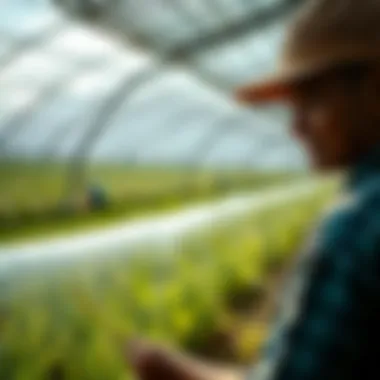Enhancing Agricultural Practices Through Malaysia Extension


Intro
Malaysia’s agricultural sector plays a pivotal role in shaping the country's economy and ensuring food security for its people. Central to the enhancement of this sector is the concept of agricultural extension services. These services, often underestimated, function as the bridge connecting technological advancements and rural farmers, thus fostering innovation and sustainable practices. By understanding the intricacies of these extension services, one can better appreciate their profound effect on farming productivity and resilience.
Agricultural extension in Malaysia is marked by a rich historical context, from its inception during the colonial era where rudimentary techniques were introduced, to its evolution into a comprehensive system that integrates modern practices. Understanding this trajectory helps in recognizing the strengths and weaknesses inherent in current practices. With farmers facing the ever-growing demands of climatic shifts and market pressures, extension services are more crucial than ever. The following sections aim to unpack the significance of these services, explore key techniques currently employed, and discuss the challenges and innovative solutions that emerge within this framework.
Through a blend of historical insights and contemporary strategies, we hope to encapsulate the essence of agricultural extension in Malaysia, providing a roadmap for stakeholders, including policymakers, agronomists, and farmers. In doing so, we contribute to the conversation surrounding sustainable agricultural development, promoting a future where food security and sustainability go hand in hand.
Preamble to Malaysia Extension
The significance of agricultural extension services in Malaysia cannot be overstated. Extension services primarily aim to bridge the gap between research and practice by providing farmers with the necessary resources, knowledge, and support to improve their agricultural techniques and productivity. In this introductory section, we will delve into the critical aspects of the Malaysia Extension, its historical significance, and its ongoing transformation to meet the ever-evolving demands of modern agriculture.
Definition of Agricultural Extension
Agricultural extension refers to the practice of delivering educational resources, practical skills, and advisory services to farmers and agricultural stakeholders with an aim to enhance farming practices and livelihoods. It encompasses a variety of methods—including workshops, field demonstrations, and one-on-one advisory sessions—designed to empower farmers with new techniques, sustainable practices, and innovative technologies. The essence of this extension work lies not just in the transfer of knowledge, but also in fostering relationships between extension workers and the communities they serve. Ultimately, effective agricultural extension can lead to increased productivity, improved food security, and greater economic stability within farming communities.
Historical Overview of Agricultural Extension in Malaysia
The roots of agricultural extension in Malaysia can be traced back to the post-colonial era, specifically the 1950s, when the government established basic extension services aimed at improving food production. It began by addressing the immediate needs of smallholder farmers who were facing challenges such as low yields and inadequate farming practices. The approach was simplistic at first, often relying heavily on government directives and top-down methodologies.
As the country evolved, so did the extension services. In the late 20th century, the focus shifted towards more participatory approaches where farmers were encouraged to engage actively in the learning process. This change recognized the vital role that local knowledge plays alongside scientific research. Furthermore, training programs for extension workers became more sophisticated, equipping them with the skills necessary to communicate effectively with diverse farming communities.
In recent years, the introduction of technology, such as mobile apps and online platforms, has transformed how extension services are delivered. These innovations have enabled farmers to access real-time data and expert advice at their fingertips. Hence, the evolution of agricultural extension in Malaysia exemplifies a journey from basic knowledge dissemination to a holistic approach that embraces modern communication tools and participatory learning.
"Effective agricultural extension is not just about information; it is about cultivating relationships that empower and uplift communities."
The landscape of agriculture in Malaysia is dynamic, and understanding the historical context of extension services helps unpack the intricate layers of challenges and opportunities that farmers face today. It paves the way for continued improvement and the adoption of best practices, driving the agricultural sector toward sustainable growth.
Aspects of the Malaysia Extension Model
Understanding the Aspects of the Malaysia Extension Model is crucial for grasping how agricultural development is shaped in this vibrant country. This model serves as a backbone to the effective dissemination of knowledge, techniques, and resources, enabling farmers to adapt to changing agricultural landscapes. The importance of this specific model lies in its ability to address unique local challenges, align with modern agricultural practices, and ultimately enhance productivity and sustainability in farming.
Key Components of Extension Services
At the heart of the Malaysia extension model, several key components stand out as integral to its functionality and impact. These include:
- Knowledge Sharing: This is one of the primary roles of extension services. It encompasses educating farmers about advanced agronomic practices, pest management, and sustainable resource use. Farmers often have traditional knowledge, but integrating scientific research elevates their practices.
- Consultative Planning: Through engaging in dialogues with farmers, extension agents can co-create solutions tailored to local conditions. This two-way communication is vital, ensuring feedback loops so farmers can express their needs and experiences, which helps shape programs accordingly.
- Capacity Building: Providing constant education and training is a hallmark of effective extension. Workshops, field demonstrations, and training sessions that are tailored to the farmers' needs can significantly boost their abilities.
- Resource Mobilization: Extension services must also focus on connecting farmers with necessary resources, including financial assistance and access to technology. This could mean facilitating access to government grants or guiding farmers in forming cooperatives to pool resources.
Each of these components works symbiotically to foster an environment of growth and learning. The strength of the Malaysia extension model resides in its adaptability; it evolves according to the changing needs of the agricultural sector.
Target Audiences for Extension Programs
Identifying the target audiences for extension programs is key to ensuring that agricultural services resonate deeply with the community they aim to serve. Generally, the primary audiences encompass:
- Smallholder Farmers: These farmers often lack access to resources and education. Tailoring extension services to them can lead to significant improvements in productivity and livelihood.
- Women in Agriculture: Engaging women in extension programs is not just equitable; it brings about transformative changes in farming communities. Women contribute substantially to agricultural labor, and programs focused on them can enhance household income and food security.
- Youth: There’s a growing recognition of the need to involve younger generations in agriculture. Programs aimed at youth can invigorate the agricultural workforce and bring fresh ideas to traditional practices.
- Indigenous Communities: These groups often have distinct farming practices shaped by cultural beliefs. Extension programs should respect and build upon these practices, ensuring inclusivity in methods that resonate within their communities.
Engagement with these different audience segments allows the Malaysia extension model to be multifaceted and adaptable. By understanding who they tailor the programs for, extension services can ensure they resonate well and achieve the intended impact, all the while fostering a community-driven approach to agriculture.
Strategies and Approaches in Malaysia Extension


In the fast-evolving world of agriculture, the significance of effective strategies and approaches in Malaysia’s extension services cannot be overstated. These frameworks serve not merely as guidelines but as lifelines for agricultural practitioners, shaping how they interact with resources, technology, and their communities. The focus here is on fostering sustainable farming practices that bridge knowledge gaps and enhance productivity.
The strategies employed in extension services hinge largely on participatory methods and the integration of technology. Such approaches enable farmers to take charge of their agricultural knowledge and practices, creating a more resilient agricultural sector that can adapt to the shifting demands of both markets and environments. This article captures the essence of these strategies, illustrating their benefits and potential considerations.
Participatory Approaches in Extension Work
Participatory approaches in extension work empower farmers by involving them directly in the learning and decision-making processes. This creates a collaborative environment where farmers feel their inputs are valued and regarded. These methods often manifest through various community-led initiatives, field demonstrations, and interactive workshops. When farmers actively participate, they are more likely to adopt new techniques that resonate with their local context.
A few key points outline why participatory methods are so effective:
- Empowerment: Farmers gain confidence and ownership of their processes and products, making them proactive in their agricultural practice.
- Localized Solutions: By directly engaging with local conditions, agricultural extensions can tailor advice specifically to the community’s needs.
- Knowledge Sharing: Community members often share insights and innovations among themselves, which can lead to unexpected and beneficial agricultural practices.
For instance, a collaboration between local farmers in the state of Johor led to the establishment of a farmer’s forum. This forum allowed individuals to exchange tips on crop rotation and pest management, significantly improving their productivity. It demonstrated how a little
collective action could lead to substantial gains in both yield and sustainability.
Integration of Technology in Agricultural Extension
As the saying goes, "There’s an app for that!" In today’s context, technology integration into agricultural practices is no longer a luxury but a necessity. Embracing digital tools can enhance the efficiency and reach of extension services. From simple mobile applications that provide weather updates and pest alerts to more sophisticated data analytics platforms, technology brings a plethora of benefits.
Some notable advantages of leveraging technology in extension include:
- Real-time Data: Access to up-to-date market information and scientific research can lead to informed decision-making by farmers.
- Wider Reach: Technology can bridge geographical gaps. Farmers in remote areas can now access information and services that were previously out of reach.
- Efficient Resource Management: Technologies like precision agriculture allow farmers to manage resources (water, fertilizers) more efficiently, reducing costs and environmental impact.
For example, the introduction of precision farming drones in Malaysia enabled farmers to monitor crop health and soil conditions remotely. This not only cuts down time spent in the field but also offers a snapshot of the health of multiple acres at once, making it easier for farmers to identify areas needing attention.
"By integrating technology, we are not just keeping up with the times; we are setting the pace for sustainable agricultural growth in Malaysia."
Impact of Extension Services on Farmers
In the vast landscape of Malaysia's agriculture, extension services play a pivotal role. They act as a bridge connecting innovative farming techniques with the growers in the field. The importance of extension services cannot be overstated, as they enhance access to information, training, and resources. For farmers seeking to boost their productivity and sustainability, these services stand as crucial support pillars.
Enhancements in Productivity and Yield
Higher productivity and yield are often synonymous with successful agricultural practices, and this is where extension services truly shine. Imagine a farmer in rural Perak, struggling with pest infestations. Through extension services, he gains access to training on integrated pest management. This knowledge empowers him to apply effective methods, organically reducing pests without detrimental environmental impact. As a result, his yield increases significantly-
- Higher Profit Margins: The added income allows for reinvestment into better equipment or seed varieties.
- Increased Crop Diversity: Farmers are encouraged to explore different crops, preventing market saturation.
- Enhanced Market Readiness: With improved yields, farmers are better positioned to fulfill contracts with buyers.
A critical aspect is the farmer's ability to adopt superior farming techniques based on researched data. Extension services often include the results of field tests, thus making these findings acutely relevant for local farmers. This closeness to the target audience creates a cycle of trust and continual improvement.
"Extension services are the lifelines for many farmers in Malaysia, providing practical solutions that transform their practices and livelihoods."
Improving Sustainability Practices
The focus on sustainability in agriculture is no longer optional; it's a necessity. Through extension services, farmers learn about sustainable practices that not only improve their current yield but also assure future profitability. Consider a farmer in Johor, who learns about crop rotation and cover cropping through an extension program. He discovers the benefits of enriching soil health without the reliance on synthetic fertilizers.
Key sustainability practices introduced through these programs include:
- Soil Conservation Techniques: Farmers learn to combat erosion and maintain soil fertility, ensuring healthier crops.
- Water Management Strategies: Efficient water usage cuts down costs and safeguards this precious resource, which is paramount in a tropical climate.
- Organic Farming Practices: By minimizing chemical inputs, farmers cater to a growing market demand for organic produce, potentially fetching higher prices.
As these sustainable practices become ingrained, the land remains fertile for generations to come. The farmers become stewards of their land, contributing positively to the ecosystem while reaping long-term benefits.
In summary, extension services serve as a linchpin for enhancing productivity and promoting sustainability among farmers in Malaysia. By providing essential resources and fostering a culture of continuous learning, they ensure that agricultural practices grow in both efficiency and environmental respect.


Challenges in the Extension Framework
The realm of agricultural extension is rife with complexities that shape its effectiveness in creating sustainable farming practices. Despite Malaysia's significant strides in agricultural extension services, a few roadblocks persist that can hinder the overall goal of enhancing productivity and sustainability among local farmers. Addressing these challenges is vital, not only for advancing agricultural practices but also for assuring food security in the nation. Understanding these challenges can illuminate pathways towards devising more efficient and pragmatic solutions.
Resource Limitations and Funding Issues
At the heart of agricultural extension challenges lie resource limitations and funding issues. Adequate funding is essential to maintain robust extension programs. Malaysia faces hurdles in allocating sufficient financial resources to develop and sustain these services. Often, funding is sporadically available, leading to a stop-and-go approach in implementing innovative strategies. This inconsistency can stymie training programs that are crucial for farmers to adopt modern techniques and technologies.
Moreover, when extension services rely on limited budgets, there is a tendency to prioritize certain regions or specific crops while neglecting others. This may deepen the divide between various farming communities and hamper collective growth. For example, smaller farms may not receive the same focus as larger ones due to their limited economic output, yet they play a pivotal role in local food supply chains.
Additionally, professionals within the extension services may face challenges like inadequate remuneration or outdated training resources, leading to decreased morale among staff. The lack of proper training or incentives can directly affect the quality of services delivered to farmers, resulting in subpar outputs or limited engagement.
Proper funding and resource allocation are the lifeblood of effective extension practices. Without financial stability, innovation stutters, and potential solutions remain out of reach.
Cultural and Communicational Barriers
Cultural and communicational barriers present another significant challenge within the extension framework. With Malaysia's diverse population, a tapestry of languages, cultures, and traditional practices exists. This diversity, while enriching, sometimes complicates the delivery of agricultural extension services. A one-size-fits-all approach may not resonate with all farmers.
For instance, certain farming communities may prefer traditional methods over modern ones. Regardless of evidence supporting modern techniques, convincing farmers to shift their mindset can be a tall order. Trust and familiarity often dictate how receptive they are to new ideas, and hence, culturally sensitive approaches are necessary for success.
Moreover, communication gaps can arise due to linguistic differences. Extension officers often need to convey complicated information in ways that resonate with the farmers, which can be challenging if they don't share a common language or cultural background. Misunderstandings can lead to farmers feeling alienated or skeptical about the benefits being proposed.
To bridge these gaps, employing local advocates or community members who understand the culture and language can be an effective strategy. Appreciating and incorporating local wisdom into extension programs can foster trust and improve engagement, ultimately making agricultural practices more effective.
Innovative Solutions for Effective Extension
In the ongoing quest for agricultural development, the need for innovative solutions is becoming undeniable. These solutions not only enhance the effectiveness of extension services in Malaysia but also ensure that farmers play an active role in maximizing agricultural productivity. When it comes to agriculture, sticking to traditional methods can sometimes be like trying to fit a square peg into a round hole. Embracing fresh, inventive strategies is crucial in addressing the multifaceted challenges farmers face today, such as climate change, resource scarcity, and technological gaps.
Collaboration with Educational Institutions
Collaboration with educational institutions is a cornerstone of effective agricultural extension. Universities and colleges don’t just produce graduates; they can serve as incubators for new ideas and practices. By partnering with these educational entities, extension services can tap into cutting-edge research and beneficial innovations that directly impact farmers.
Institutions like Universiti Putra Malaysia and Universiti Malaya play a pivotal role by conducting research on pest resistance, crop varieties, and sustainable practices. Through joint initiatives, farmers can receive updated training and access to the latest resources and technologies. This means the gap between theoretical knowledge and field application can be easily bridged.
Moreover, when educational institutions engage in outreach programs, they can significantly boost farmer participation in training workshops. It creates a direct line of communication where farmers feel their voices are heard, fostering a sense of ownership in the agricultural processes. Here are some key points to consider about this collaboration:
- Research-Driven Practices: Advances in agricultural science translate directly into practices that farmers can implement, increasing yield and efficiency.
- Hands-On Training: Workshops and seminars hosted by educational institutions provide farmers with hands-on experiences that sharpen their skills.
- Feedback Loop: Educational institutions gain valuable insights from farmers that guide future research and extension practices.
Utilization of Digital Platforms for Outreach
The 21st century is largely defined by digital transformation, and Malaysian agriculture is not exempt from this trend. Utilizing digital platforms for outreach revolutionizes how extension services communicate with farmers. From social media to dedicated agricultural apps, technology provides pathways to engage farmers instantaneously and effectively.
With many of Malaysia's rural farmers now possessing smartphones, leveraging these devices can yield impressive results. For example, mobile apps like "MyAgri" allow farmers to access real-time market prices, weather forecasts, and expert advice, all at their fingertips. This immediacy not only enhances decision-making but also ensures farmers are well-informed before making critical choices.
Digital platforms elevate the scope of extension services well beyond geographical constraints. Here's how:
- Wider Reach: Social media can connect thousands of farmers, allowing for widespread dissemination of information quickly and efficiently.
- Interactive Learning: Platforms enable real-time Q&A sessions with agricultural experts, making it easy for farmers to seek answers to pressing questions without waiting for a formal meeting.
- Resource Sharing: Farmers can access a wealth of resources online, from instructional videos to research articles, broadening their knowledge and skill sets.
The integration of digital solutions represents a fundamental shift in how extension services operate, bringing benefits that can be seen in greater crop yields and enhanced sustainable practices.


Incorporating innovative solutions, like collaborating with educational institutions and using digital platforms, presents a promising pathway for improving Malaysia’s agricultural extension services. By adapting to modern needs and leveraging the resources available, extension services can become much more effective, fostering a more resilient agricultural community.
Case Studies of Successful Extension Initiatives
The significance of exploring successful extension initiatives in Malaysia cannot be understated. These real-world examples serve as a beacon for farmers, extension workers, and policymakers alike. Not only do they showcase practical applications of theoretical models, but they also shed light on the problems faced in the field and the creative solutions devised to overcome them. Identifying these successful programs offers a chance to disseminate effective practices that could be replicated or adapted across different contexts. This section will delve into notable programs and their eventual outcomes, underlining the importance of tangible case studies in the broader discussion of agricultural extension.
Notable Programs in Malaysian Agriculture
In Malaysia, several programs stand out for their innovative approaches and successful implementations:
- Paddy Production Enhancement Program (PPEP): Launched by the Ministry of Agriculture, this program aims to boost paddy yield through integrated practices, including water management and the use of quality seeds. Farmers who participated reported an increased yield of up to 30%, proving the value of targeted extension services.
- Agroforestry Development Initiatives: These initiatives promote sustainable land use by integrating trees into crop systems. One success story from the northern region showed farmers who adopted agroforestry practices achieved greater biodiversity on their farms and improved their overall resilience against pests and diseases.
- Livestock Improvement Scheme: Aimed at enhancing the genetic quality of local livestock through improved breeding techniques. The results indicate that farmers experienced a 50% rise in milk production, evidenced by higher milk yields from enhanced cow breeds promoted through extension activities.
"Case studies not only reveal what's possible but also show how extension services can catalyze change in agriculture."
These examples highlight the fusion of extension services with practical agricultural challenges, showcasing a pathway toward improved agricultural practices in Malaysia. When farmers see real results from their neighbor’s fields or hear success stories from fellow producers, the motivation to participate in extension programs grows.
Analysis of Impact and Lessons Learned
The impact of these extension initiatives extends beyond just numbers; they influence community structures, promote sustainable practices, and enhance farmer’s livelihoods. Assessing the lessons learned from these studies can provide vital insights for future extension programs:
- Engagement Matters: Successful engagement of farmers is crucial. Initiatives that actively involve farmers in decision-making processes tend to see higher rates of participation and compliance.
- Tailored Solutions: One-size-fits-all approaches rarely yield fruit. Understanding the local context and specific needs can significantly increase the effectiveness of the extension services.
- Collaboration with Local Institutions: Partnering with local agricultural institutions can amplify the message and effectiveness of extension initiatives. When farmers receive training from those who understand their regional challenges, the results can be game-changing.
- Continuous Evaluation: Adaptability is key. Programs should allow for feedback mechanisms, enabling adjustments as needed to respond to changing conditions or challenges in real-time.
The successful extension initiatives in Malaysia give a roadmap for the future, underscoring the essence of collaboration, engagement, and customized approaches tailored not just to the challenges of farming, but to the very fabric of the communities they serve. For anyone involved in Malaysian agriculture, these lessons could be pivotal in shaping the success of upcoming initiatives.
Future Directions for Malaysia Extension
In examining the future directions for Malaysia’s agricultural extension, it’s crucial to recognize how these evolving practices can pave the way for more sustainable and efficient farming. With the pressures of climate change, economic shifts, and the need for increased food security, agricultural extension services must adapt and innovate. This section delves into the emerging trends that could define this future alongside essential recommendations for policy development.
Emerging Trends in Agricultural Extension
As we look ahead, there are several trends that are shaping the landscape of agricultural extension in Malaysia:
- Digital Agriculture: The integration of digital tools is becoming indispensable. Farmers are adopting mobile applications that provide real-time weather updates, pest alerts, and market prices, fostering more informed decision-making.
- Data-Driven Approaches: With advanced analytics and data collection, extension services can tailor programs that cater specifically to regional needs. This results in better-targeted advice that is relevant to local contexts.
- Sustainability Focus: As farming continues to face environmental challenges, practices centered around sustainability are gaining traction. Techniques such as regenerative agriculture are gaining attention. Extension programs should promote concepts that help preserve resources while increasing yields.
- Community Involvement: Engaging local communities in the creation and execution of extension initiatives is emerging as a paramount trend. This participatory method ensures that the solutions provided are not only culturally appropriate but also widely accepted and implemented.
These trends indicate that the future of agricultural extension in Malaysia will require a blend of technological innovation and community engagement to successfully navigate the complexities of modern agriculture.
Recommendations for Policy Development
A forward-looking policy framework is necessary to harness the potential of these emerging trends. Here are some recommendations for policymakers:
- Invest in Technology Infrastructure: Funding should be allocated for the development of digital platforms that enhance communication between extension agents and farmers.
- Training Programs for Extension Workers: Continuous professional development can keep extension workers updated on the latest agricultural practices and technologies. This, in turn, ensures that farmers receive timely and relevant information.
- Incentivizing Sustainable Practices: Policies should support and reward farmers who adopt sustainable farming techniques. Crop rotation and organic practices, for instance, can be promoted through subsidies or grants.
- Collaboration with Local Institutions: Partnering with universities and research organizations can not only enrich the knowledge base but also lead to the development of innovative solutions tailored to local agricultural challenges.
- Establishing Feedback Mechanisms: It’s imperative to create channels for farmers to voice their concerns or feedback regarding extension services, ensuring that the programs remain responsive and adaptive to their needs.
Successful agricultural extension relies heavily on adaptability and responsiveness to the ever-changing landscape of farming, as well as on the ability to connect deeper with the farming community.
The future directions for Malaysia’s agricultural extension services hold great promise, provided there is ample emphasis on technological advancement, sustainability, and community involvement. By fostering these areas, the agricultural sector can not only mitigate current challenges but thrive amid them.
Epilogue
In the realm of agricultural advancement, the importance of extension services cannot be overlooked, especially in Malaysia. These services act as a bridge, connecting farmers with current research, technological advancements, and sustainable practices. When we consider the crucial role they play in shaping agricultural growth, one can see that extension services are not merely a set of programs; they are a lifeline for farmers aiming to improve their productivity and address challenges head-on.
One primary aspect worth noting is how extension services have evolved to cater specifically to the needs of the local farming community. By tailoring strategies that resonate with cultural practices and available resources, they enhance relevance and effectiveness. This is vital in a country where agricultural practices are as diverse as its people.
Furthermore, the benefits of these services extend beyond mere output and yield improvements. They also encourage environmental stewardship. Integrating sustainable agricultural practices into extension programs equips farmers with the knowledge to cultivate land responsibly, ensuring that resources for future generations are preserved. This speaks to a broader, almost philosophical consideration about our relationship with nature and the responsibility we hold towards it.
However, the journey is not without its hurdles. Various constraints such as resource limitations and funding issues persist, demanding continuous innovation in service delivery. The engagement of local communities and the adaptation of modern technology are paramount. As Malaysia moves forward, it must foster a culture of learning and collaboration between stakeholders at all levels – from policymakers to educators and farmers.
In summary, the effectiveness of agricultural extension in Malaysia is crucial for not just immediate agricultural growth, but for long-term sustainability. Fostering an environment where farmers can thrive should remain at the forefront of agricultural discourse and policy. The road ahead is one of opportunity, set against the backdrop of an ever-evolving agricultural landscape.



